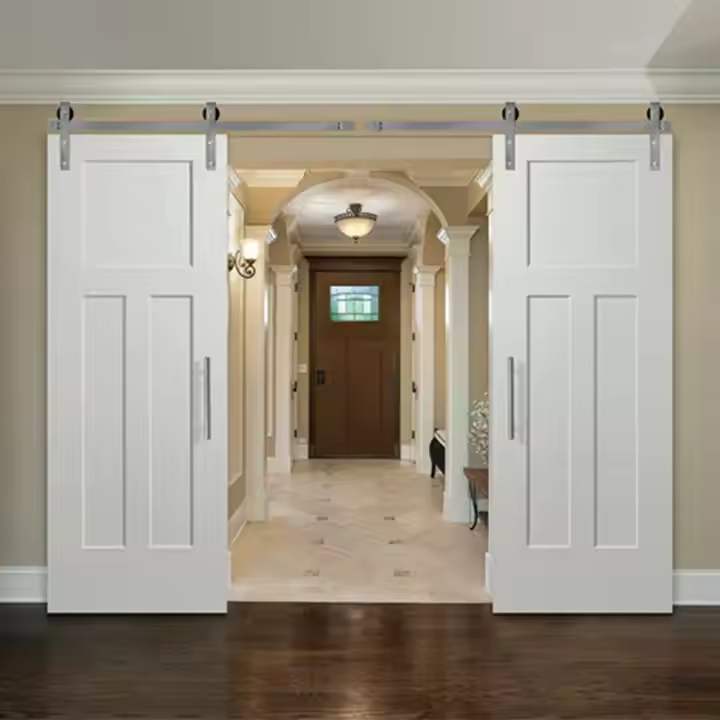When it comes to ensuring the safety and functionality of your trailer, one of the most crucial aspects is its interior, specifically the trailer doors interior. Whether you use your trailer for transportation, storage, or even as a mobile office, understanding the importance of trailer doors interior and making informed decisions about its design and features can make all the difference.In this guide, we will explore everything you need to know about trailer doors interior, from different types and materials to installation tips and maintenance advice. Let’s dive in.
What Is the Importance of Trailer Doors Interior?
The trailer doors interior plays a vital role in protecting the contents of the trailer. Not only does it serve as an access point, but it also contributes to the overall security and insulation of the space. A well-designed trailer door interior can help in organizing cargo, keeping it safe during transit, and providing ease of access.
Here are a few reasons why trailer doors interior is crucial:
- Security: A properly designed interior prevents theft and vandalism by providing strong and reliable locking mechanisms.
- Organization: It can offer an organized storage space by using interior fixtures and components, which makes loading and unloading easier.
- Insulation: The trailer doors can help in controlling the internal temperature of the trailer by using insulated materials.
- Ease of Use: Well-designed trailer doors are easier to open, close, and manage, which improves convenience for drivers and operators.
Different Types of Trailer Doors Interior
When it comes to choosing the right interior for your trailer doors, there are several options available depending on the specific needs of your trailer. Here are the most common types of trailer doors interior:
1. Swing Doors
Swing doors are among the most commonly used types for trailers. They are hinged on the sides and open outwards, providing full access to the interior. The trailer doors interior for swing doors is usually equipped with robust materials to ensure strength and security.
Pros:
- Easy to install and operate
- Provides wide access for loading and unloading
- Cost-effective
Cons:
- Requires more space to open fully
- Can be damaged if not properly maintained
2. Roll-Up Doors
Roll-up doors are ideal for trailers that require frequent access or when there is limited space for swing doors. These doors are designed to roll up into a coil and provide smooth and easy access to the interior of the trailer.
Pros:
- Saves space since they do not need room to open
- Offers a sleek and modern look
- Provides good security and protection
Cons:
- May require more maintenance due to the mechanical components
- Can be more expensive than swing doors
3. Ramp Doors
Ramp doors are often used in trailers that transport heavy or oversized cargo, as they provide an easy way to load and unload goods. These doors double as a ramp when lowered, making it simple to move heavy equipment, vehicles, or machinery in and out of the trailer.
Pros:
- Ideal for heavy-duty transportation
- Makes loading and unloading easier
- Can be used as a ramp for vehicles
Cons:
- Not suitable for all types of cargo
- Requires additional structural support
4. Bi-Fold Doors
Bi-fold doors consist of two sections that fold in half when opened. This design is compact, offering an efficient way to use limited space without sacrificing ease of access to the trailer’s interior.
Pros:
- Saves space and provides easy access
- Ideal for smaller trailers or those with limited door clearance
- Provides a modern, sleek design
Cons:
- May be more expensive than other types
- Can be more complex to maintain and repair

Materials Used for Trailer Doors Interior
The choice of materials for your trailer doors interior can affect both its functionality and longevity. Here are some common materials used:
1. Aluminum
Aluminum is widely used for trailer doors interior due to its lightweight nature and resistance to corrosion. It’s a popular choice for those who need to reduce the overall weight of their trailer.
Advantages:
- Lightweight
- Rust-resistant
- Easy to maintain
Disadvantages:
- Can be expensive
- Prone to dents and scratches
2. Steel
Steel is known for its strength and durability. It provides excellent security and protection for trailer contents, but it is heavier than aluminum.
Advantages:
- Extremely durable
- Offers superior security and protection
- Can support heavy loads
Disadvantages:
- Heavier than aluminum
- Susceptible to rust if not properly treated
3. Fiberglass
Fiberglass offers a lightweight and durable option for trailer doors interior. It’s also resistant to weather damage, making it a good choice for trailers that are exposed to harsh environmental conditions.
Advantages:
- Lightweight and durable
- Resistant to corrosion and weather damage
- Provides good insulation
Disadvantages:
- Can be expensive
- Can crack or chip under heavy impact
4. Wood
Wood is a traditional choice for trailer doors interior, especially in older models. It provides natural insulation and is easy to work with for custom designs.
Advantages:
- Offers natural insulation properties
- Can be customized easily
- Aesthetic appeal for specific trailer types
Disadvantages:
- Prone to damage from moisture and rot
- Requires more maintenance than other materials
How to Maintain Trailer Doors Interior
Proper maintenance of trailer doors interior is essential to ensure that the doors remain functional and secure. Here are some tips to help you maintain your trailer doors:
1. Regular Cleaning
Dirt and debris can cause wear and tear on your trailer doors interior. Regular cleaning can prevent buildup that can cause damage or obstruct the doors from operating smoothly.
- Use a soft cloth or brush to clean the surface.
- Clean both the inside and outside of the doors.
- Avoid harsh chemicals that may damage the material.
2. Lubricate Moving Parts
For swing and roll-up doors, lubricating hinges, locks, and other moving parts can help them operate smoothly and prevent rust or corrosion. Apply lubricant regularly to avoid wear and tear.
3. Inspect for Damage
Regularly inspect your trailer doors interior for any signs of damage such as dents, rust, or cracks. Repairing small issues immediately can prevent them from escalating into more significant problems.
- Check the seals for cracks that may allow moisture inside.
- Look for any loose screws or hardware that need tightening.
4. Repaint or Refinish as Needed
If your trailer doors interior starts showing signs of wear, consider repainting or refinishing the material to restore its appearance and protect it from further damage. This is especially important for wood or steel doors, which may deteriorate over time.
Conclusion
The trailer doors interior is a critical part of your trailer’s design, serving as the gateway to the cargo and providing security, organization, and insulation. By understanding the different types of trailer doors and materials, as well as how to maintain them, you can make sure that your trailer doors interior remains in optimal condition for years to come.Whether you’re looking for added security, easier access, or better insulation, choosing the right trailer doors interior can make a significant difference in the performance and longevity of your trailer. Make informed decisions, and your trailer will continue to serve you well for many years to come.












 Afrikaans
Afrikaans Shqip
Shqip አማርኛ
አማርኛ العربية
العربية Հայերեն
Հայերեն Azərbaycan dili
Azərbaycan dili Euskara
Euskara Беларуская мова
Беларуская мова বাংলা
বাংলা Bosanski
Bosanski Български
Български Català
Català Cebuano
Cebuano Chichewa
Chichewa 简体中文
简体中文 繁體中文
繁體中文 Corsu
Corsu Hrvatski
Hrvatski Čeština
Čeština Dansk
Dansk Nederlands
Nederlands English
English Esperanto
Esperanto Eesti
Eesti Filipino
Filipino Suomi
Suomi Français
Français Frysk
Frysk Galego
Galego ქართული
ქართული Deutsch
Deutsch Ελληνικά
Ελληνικά ગુજરાતી
ગુજરાતી Kreyol ayisyen
Kreyol ayisyen Harshen Hausa
Harshen Hausa Ōlelo Hawaiʻi
Ōlelo Hawaiʻi עִבְרִית
עִבְרִית हिन्दी
हिन्दी Hmong
Hmong Magyar
Magyar Íslenska
Íslenska Igbo
Igbo Bahasa Indonesia
Bahasa Indonesia Gaeilge
Gaeilge Italiano
Italiano 日本語
日本語 Basa Jawa
Basa Jawa ಕನ್ನಡ
ಕನ್ನಡ Қазақ тілі
Қазақ тілі ភាសាខ្មែរ
ភាសាខ្មែរ 한국어
한국어 كوردی
كوردی Кыргызча
Кыргызча ພາສາລາວ
ພາສາລາວ Latin
Latin Latviešu valoda
Latviešu valoda Lietuvių kalba
Lietuvių kalba Lëtzebuergesch
Lëtzebuergesch Македонски јазик
Македонски јазик Malagasy
Malagasy Bahasa Melayu
Bahasa Melayu മലയാളം
മലയാളം Maltese
Maltese Te Reo Māori
Te Reo Māori मराठी
मराठी Монгол
Монгол ဗမာစာ
ဗမာစာ नेपाली
नेपाली Norsk bokmål
Norsk bokmål پښتو
پښتو فارسی
فارسی Polski
Polski Português
Português ਪੰਜਾਬੀ
ਪੰਜਾਬੀ Română
Română Русский
Русский Samoan
Samoan Gàidhlig
Gàidhlig Српски језик
Српски језик Sesotho
Sesotho Shona
Shona سنڌي
سنڌي සිංහල
සිංහල Slovenčina
Slovenčina Slovenščina
Slovenščina Afsoomaali
Afsoomaali Español
Español Basa Sunda
Basa Sunda Kiswahili
Kiswahili Svenska
Svenska Тоҷикӣ
Тоҷикӣ தமிழ்
தமிழ் తెలుగు
తెలుగు ไทย
ไทย Türkçe
Türkçe Українська
Українська اردو
اردو O‘zbekcha
O‘zbekcha Tiếng Việt
Tiếng Việt Cymraeg
Cymraeg isiXhosa
isiXhosa יידיש
יידיש Yorùbá
Yorùbá Zulu
Zulu